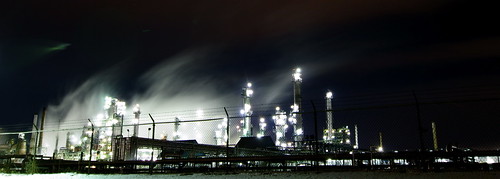
Flint Hills Resources' Pine Bend Refinery (Flickr/Chuck Olson)
Here in Minnesota, we don't have any fossil fuel resources of our own. There are no oil wells, fields of natural gas, or coal mines anywhere in the state. While the state has committed to using more and more renewables over time, we have to import most of our energy from elsewhere—and that mostly means Canada.
About 80% of our oil comes from Canada, fed into the state via the Enbridge Pipeline System—historically known as the Lakehead Pipeline. When it was first built in 1950, it ran almost 1,000 miles from Edmonton, Alberta to Superior, Wisconsin. A few years later, it was extended all the way to Sarnia, Ontario. A junction point at Clearbrook, Minnesota connects to the Minnesota Pipeline, which brings petroleum down to refineries in Rosemount and Saint Paul Park.
Over time, an increasing amount of the material sent through the pipeline has been synthetic crude oil extracted from the Athabasca oil sands region in northern Alberta. In areas where the oil sands are near the surface, petroleum has mostly come from strip-mining operations. Bitumen is dug up from the ground, then sent through a process to heat and dissolve the sticky oil so that it releases itself from the sand and clay particles embedded within.
This is mostly done in factory-style operations these days, where material dug up from the ground is fed into large above-ground equipment. Newer projects in the area are working on how to extract fuel from deposits farther underground that are difficult to reach through strip-mining. In the future, it appears that more operations will drill down to inject steam and other solvents into oil sands formations to try and loosen up the material in-place, then pump it out and do futher processing.
These are messy processes that have caused drastic changes to occur in the Athabasca region. Large amounts of water are needed in the recovery process. Lots of waste materials are also produced, which are often stored in large above-ground ponds. Tar sands extraction is also energy-intensive, meaning that the oil used in Minnesota has a higher energy overhead than fuel produced by more traditional processes, though there is some hope that newer methods of extraction may decrease the amount of energy required to pull a unit of synthetic crude out of the ground.
Our lack of internal fossil fuel resources is one reason why Minnesota has been a leader among our nation's states in terms of renewable energy production. We had the country's first statewide mandate for 10% ethanol in our gasoline back in 1997, followed several years later by biodiesel blending requirements (currently set at 5%). We've been among the top states for wind energy production for many years as well.
This doesn't mean that we can stop, however. Oil sands are being used to produce more and more of our oil each year. The amount used by our state is unclear, but Canadian oil sources have shifted to the point where about half of their production comes from oil sands today. If this holds for Minnesota, 30 to 40 percent of our liquid fuel comes from tar sands, and it's an ever-increasing proportion.
This is one reason why I personally choose to drive less and walk, bike, and take transit more. Even though my car is a fairly economical Volkswagen Jetta TDI (diesel), it seems to me that it is likely to become less efficient over time because of processes happening long before a drop of oil hits my fuel tank.
A version of this article also appears at streets.mn.
No comments:
Post a Comment